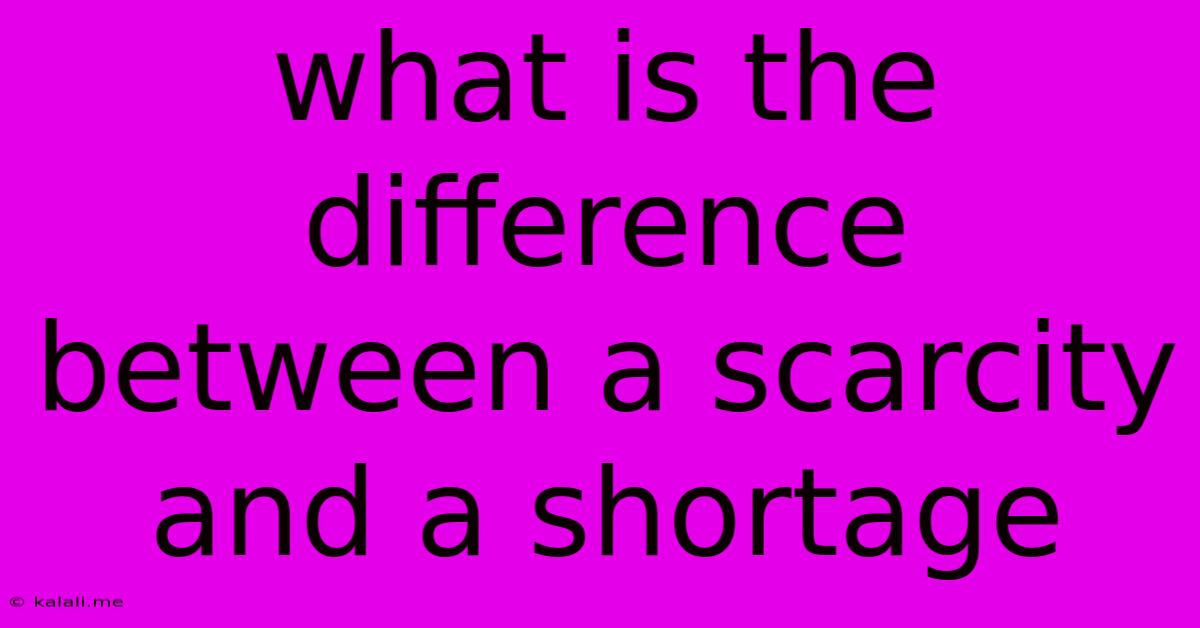What Is The Difference Between A Scarcity And A Shortage
Kalali
Jun 12, 2025 · 3 min read

Table of Contents
Scarcity vs. Shortage: Understanding the Key Differences
Meta Description: Learn the crucial difference between scarcity and shortage. This article clarifies these economic concepts, explaining their implications for supply, demand, and market dynamics. Understand how limited resources and temporary supply disruptions impact pricing and consumer behavior.
Scarcity and shortage are often used interchangeably, but they represent distinct economic concepts with significant implications for resource allocation, pricing, and market behavior. While both involve limited availability of goods or services, their underlying causes and consequences differ considerably. Understanding this difference is crucial for anyone interested in economics, business, or simply navigating the complexities of the modern marketplace.
What is Scarcity?
Scarcity is a fundamental economic principle referring to the inherent limitation of resources relative to unlimited human wants and needs. Essentially, there's never enough of anything to satisfy everyone completely. This isn't a temporary condition; it's a permanent state of affairs. Think of land, raw materials, time, or even skilled labor – all are scarce resources. The scarcity of resources forces us to make choices, prioritizing some uses over others. This leads to opportunity costs—the value of the next best alternative forgone.
- Key Characteristics of Scarcity:
- Permanent: Scarcity is an inherent and ongoing condition.
- Relative: Scarcity is relative to demand; a resource might be abundant in one area but scarce in another.
- Fundamental Economic Problem: Scarcity is the root cause of the fundamental economic problem: how to allocate limited resources to satisfy unlimited wants.
What is a Shortage?
A shortage, on the other hand, is a temporary condition where the quantity demanded of a good or service exceeds the quantity supplied at a given price. It's a market imbalance, often caused by unforeseen events or disruptions. Unlike scarcity, a shortage can, in theory, be resolved by adjusting prices or increasing production.
- Key Characteristics of a Shortage:
- Temporary: Shortages are typically temporary imbalances that can be rectified.
- Price-Related: Shortages are often a direct result of a price being set below the market equilibrium price, creating excess demand.
- Supply-Side Issues: Shortages can also stem from disruptions in the supply chain, natural disasters, or unexpected increases in demand.
Examples Illustrating the Difference
Let's look at some examples to solidify the distinction:
-
Oil: Oil is a scarce resource. There's a finite amount of oil on Earth, and its extraction and refinement require significant resources. However, an oil shortage could occur due to geopolitical instability disrupting supply, leading to higher prices and rationing.
-
Clean Water: Access to clean water is increasingly scarce globally, especially in arid regions. This scarcity necessitates careful management and allocation. A shortage of clean water might arise locally due to a drought or a broken water main.
-
Labor: Skilled labor in certain specialized fields is scarce. This leads to higher wages for those possessing these skills. A shortage of nurses in a specific hospital could occur due to a sudden influx of patients or insufficient staffing levels.
Implications for Businesses and Consumers
Understanding the difference between scarcity and shortage is crucial for businesses and consumers. Businesses need to anticipate long-term implications of resource scarcity and navigate the temporary challenges of shortages. Consumers must understand that the prices of scarce resources will naturally be higher, while shortage-driven price increases are potentially temporary. Effective resource management and proactive planning are key to mitigating the negative effects of both scarcity and shortages.
In conclusion, while both scarcity and shortage involve limited availability, scarcity is an inherent and persistent condition reflecting the fundamental economic problem, while shortages are temporary imbalances that can, in principle, be resolved. Recognizing this distinction provides valuable insights into market dynamics and informs better decision-making in both economic and business contexts.
Latest Posts
Latest Posts
-
Which Of The Following Is Not True About Water
Jun 13, 2025
-
How Many Faces Edges And Vertices Does A Hemisphere Have
Jun 13, 2025
-
What Is Lv In Roman Numerals
Jun 13, 2025
-
Indus Valley Civilization Pdf For Class 6
Jun 13, 2025
-
Which Of The Following Is A Secondary Air Pollutant
Jun 13, 2025
Related Post
Thank you for visiting our website which covers about What Is The Difference Between A Scarcity And A Shortage . We hope the information provided has been useful to you. Feel free to contact us if you have any questions or need further assistance. See you next time and don't miss to bookmark.